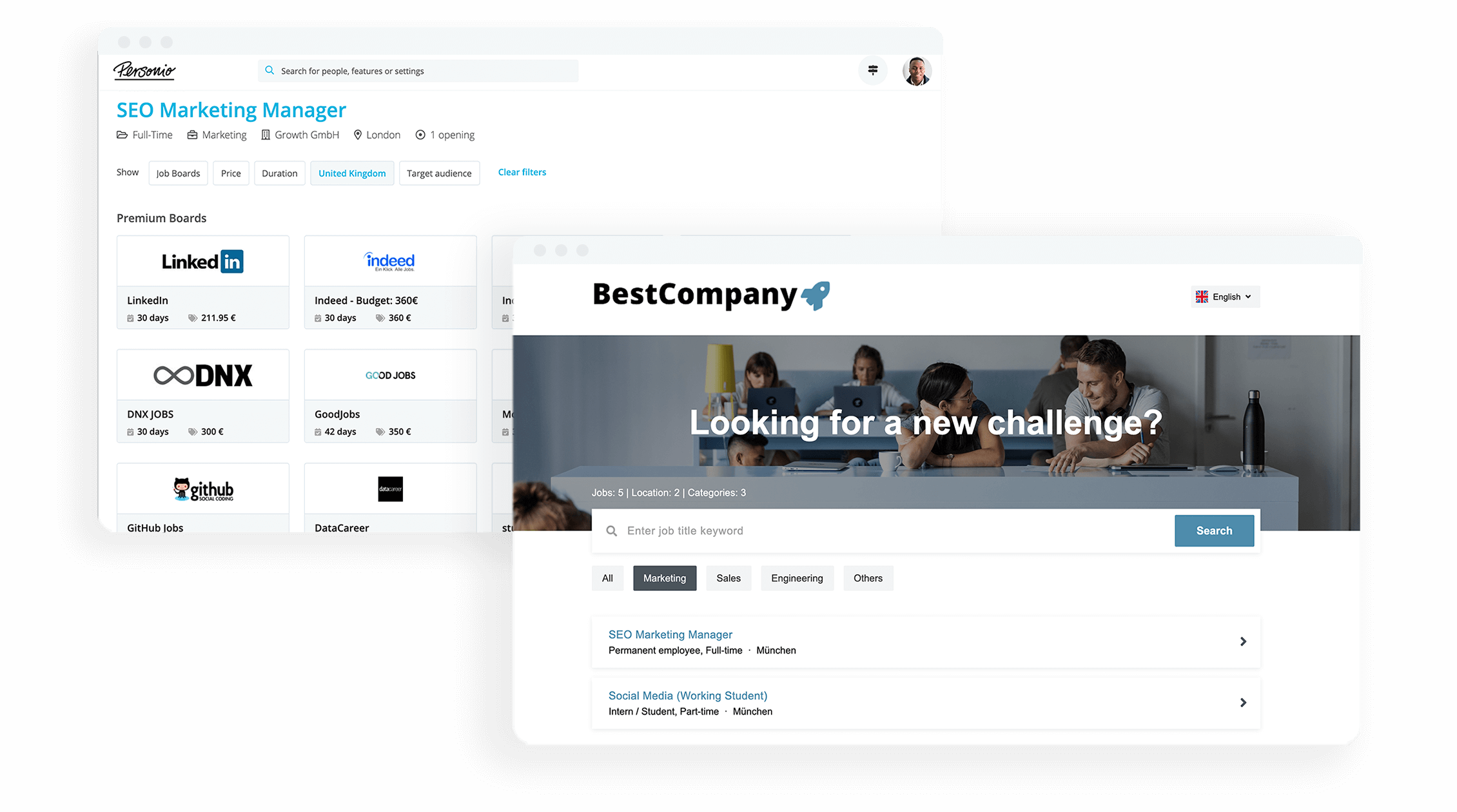What is an Employer of Record?

An employer of record (EOR) can be a key player in the global expansion of many companies. Can having an employer of record on board be your team’s next big competitive advantage? Read our guide for more on EoRs in the UK.
Personio EOR is powered by Remote, a leading provider of global EOR services. With this you can hire, onboard, manage and pay employees worldwide without the cost or complexities of opening up new legal entities.
Hire in record time with a leading Applicant Tracking System (ATS).Contents
- 1What Is an Employer of Record?
- 2How Does an Employer of Record Work?
- 3Pros and Cons of an Employer of Record?
- 4Should Your Organisation Consider an Employer of Record?
- 5What Is the Difference Between an Employer of Record and a PEO?
- 6How Does an Employer of Record Differ From HR Software?
- 7Do You Need an Employer of Record or HR Software?
What Is an Employer of Record?
An employer of record (EOR) is an organisation that is legally responsible for employment matters on behalf of an employer. The employees perform their work for their employer, while the EOR handles the administrative and legal responsibilities associated with employing them.
These can include:
Payroll and tax withholding
Unemployment insurance
Workers’ compensation insurance
Compliance with laws and regulations
Personio EOR, powered by Remote, describes an EOR as a service provider that simplifies the process of hiring internationally by acting as your legal partner in over 60 countries. These platforms ensure transparency and compliance, to allow you to focus on growing your business.
Learn more about Remote’s take on EORs here.
How Does an Employer of Record Work?
The Employer of Record model originated in the USA in the 1960s, where companies faced challenges when employing people across state lines. These days, many teams are international, and an EOR can help companies hire people from other countries.
When a company uses an EOR, there is a three-sided contract signed by the company, the employee and the EOR:
The company and the employee maintain a direct relationship. The company is responsible for assigning their work tasks, managing performance and anything else that goes along with the work itself.
The EOR is the legal employer of said employee. They handle the administrative and legal responsibilities, including payroll, taxes, benefits, compliance, etc. Global EORs may also handle things like employee visas and taxation issues in the host country.
The employee is responsible for executing their obligations set forth in the job description.
Hire and manage global talent — without barriers

Easily hire, pay and manage global employees without setting up your own local entities. Let Remote’s local experts handle payroll, benefits, compliance and more.
Find out morePros and Cons of an Employer of Record?
As with any business service or relationship, there are benefits and drawbacks to engaging an Employer of Record…
What Are the Benefits of an Employer of Record?
An Employer of Record can offer many benefits. For starters, utilising an EOR can provide a valuable service to businesses who don’t have the time or resources to handle the complicated paperwork and requirements involved in employing people. This is especially relevant for companies who are expanding to different employment regions (e.g. different countries or across state lines in the US).
It’s becoming more and more common for companies to set up operations abroad or hire remote workers who do not need to travel to work. However, this often requires much more than just registering a tax number or filing annual tax returns to be compliant. Using an EOR is an efficient way to quickly expand a business with local staff and comply with local laws, while also providing protections and benefits to employees.
An Employer of Record can be an effective solution to work through compliance obstacles, mitigate the risks of employment in complex jurisdictions, and expand operations efficiently.
With an EOR service provider like Personio EOR, powered by Remote, you can also benefit from their role in taking on the responsibility as a legal employer and ensuring compliance with local labour laws and provisions of respective countries. The employment relationship is managed in accordance with the law.
What Are the Drawbacks of an Employer of Record?
While an Employer of Record can be a great option, there are drawbacks – and it’s not the right option for every business.
First, working with an EOR may leave those within the business feeling like they have less control. No matter the level of involvement of the EOR, handing over ownership of core administrative processes can feel challenging.
Additionally, handing over these processes will take a large load of work off other teams within the company, especially HR. While this isn’t inherently a bad thing, it can mean many jobs are being outsourced and HR won’t be as heavily involved in the day-to-day operations. Companies using an EOR may need to rethink the setup of the in-house HR department to ensure it remains effective.
Finally, using an EOR may lead to shifts in the company culture. Handing over core processes and inviting another entity into the employee relationship could impact the employee’s view of the employer. This can be mitigated as long as the company is aware of this challenge and actively working to build (and maintain) a culture that aligns with the vision and values.
Discover Personio: More Talent For 45% Less Cost

Hire the best talent, no matter where they are, with Personio Posting Bundles. Gain access to visibility on Europe’s top job portals — click below to learn more.
How it worksShould Your Organisation Consider an Employer of Record?
Using an Employer of Record can be a great gateway to building a distributed workforce and ensuring compliance across jurisdictions. When deciding whether your organisation should work with an EOR, consider questions such as:
Do you plan to explore new markets?
How do you plan to acquire and retain talent in your various areas of operation?
How will you approach classification of contractors?
Do you have in-house resources for international employment law compliance?
How much control are you willing to give up when it comes to your employees and various admin processes?
Do you have other multi-country providers that can handle the compliance challenges?
Where do you need coverage (i.e. in which markets do you need to hire employees)?
Answering these questions can help your organisation gauge whether an Employer of Record is the right option for you, or if you may want to consider additional choices like a PEO.
According to the experts at Remote, as EOR models become more and more popular, it's also becoming a more efficient and compliant solution. In their view, organisations who have otherwise employed a host of freelancers are making the move to this relationship.
Ready to learn more? Sign up for Personio EOR, powered by Remote today.
What Is the Difference Between an Employer of Record and a PEO?
A professional employer organisation, or PEO, is another category of third-party employee management service.
While Employers of Record and PEOs are similar, they do provide different services. For example:
Responsibilities – Businesses who work with a PEO have a “co-employment relationship”, meaning the responsibilities are shared. This differs from an EOR, which is the full legal employer.
Contracts – Because of this co-employment relationship, employment contracts are between the business and its employees, while the PEO has a separate client service agreement.
Registration – With a PEO, the business client must still establish a presence in each place where it has employees. With an EOR, however, the company can have workers anywhere the EOR has a presence, since they are not responsible for co-employment.
Insurance – Businesses typically have to have coverage under the PEO’s insurance policy, which might mean needing additional coverage or taking out an employment insurance policy. An EOR carries its own insurance policies (unemployment, disability, workers compensation, etc.) under which the employees are covered.
In order to be able to use a PEO, companies needs their own branch in their selected country. This makes the customer an employee and responsible for compliance with local labour laws. Liability and risks are shared in the PEO model.
Additionally, a PEO typically requires a minimal number of employees, while an Employer of Record can work for an organisation of any size.
How Does an Employer of Record Differ From HR Software?
An Employer of Record is a third-party provider that takes on the legal employment of a company’s workers. HR software is a digital solution that enables an organisation to manage and optimise its human resources tasks and goals.
Do You Need an Employer of Record or HR Software?
Whether you need an Employer of Record, HR software or a bit of both depends on your specific business needs.
If you are hiring across countries and can’t handle the compliance on your own, you may choose to work with an Employer of Record.
However, companies who engage with an Employer of Record will still likely need an HR software solution, as most will still have an internal HR team and will need to handle areas like performance management, learning and development, knowledge sharing and more.
Personio has built our own EOR by embedding Remote in our platform. This enables you to spend less time on processes and more time on people – especially important if you are working with a distributed team. Speak with an expert today to learn more.
Disclaimer
We would like to inform you that the contents of our website (including any legal contributions) are for non-binding informational purposes only and does not in any way constitute legal advice. The content of this information cannot and is not intended to replace individual and binding legal advice from e.g. a lawyer that addresses your specific situation. In this respect, all information provided is without guarantee of correctness, completeness and up-to-dateness.
